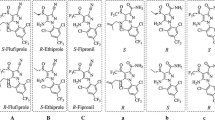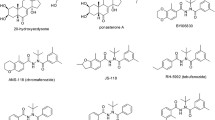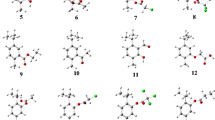Abstract
In this research, the optimised structural and vibrational properties of cis–trans isomers of powerful insecticide allethrin were theoretically studied in gas phase and in aqueous and ethanol solutions by using hybrid B3LYP/6–311 + + g(d,p) level of theory. The results revealed that the permittivity of solvent has influence on the properties of both isomers, thus, higher dipole moments and solvation energies are observed in water, a solvent of higher permittivity (78.355) than ethanol. Complete vibrational assignments of both isomers were done by combining the experimental IR spectrum of allethrin with the scaled quantum mechanical force field (SQMFF) methodology and the determination of corresponding scaled force constants in gas phase and aqueous solution are reported. Different signs of dihedral O2C10C6C4 angles of both isomers (negative in cis and positive in trans) support the differences in the vibrational assignments. Natural bond orbital (NBO) calculations suggest that both isomers are highly stable in gas phase and aqueous solution and that the side chains and five member’s rings are involved in the n → σ* interactions. However, atoms in molecules (AIM) studies reveal a higher stability of form cis in both media than the trans one. Merz-Kollman (MK), Mulliken and natural population atomic (NPA) charges for both isomers support the higher hydration of trans isomer in aqueous media and, hence, the higher solvation energy in water (ΔGC/ZPVE = − 80.29 kJ/mol). Changes in the bond orders of O and C atoms of side chain are observed in water as a consequence of hydration. The higher stability of the cis form in the above solutions could be explained by the lower solvation energy in water, as supported by AIM calculations. The studies of frontier orbital reveal that the cis form in both media is sligthly more reactive than the trans form.
Graphical abstract





Similar content being viewed by others
Data availability
Available when the authors require it.
Code availability
Not applicable.
References
Castillo MV, Pergomet JL, Carnavale GA, Davies L, Zinczuk J, Brandán SA (2015) A complete vibrational study on a potential environmental toxicant agent, the 3,3’,4,4’-tetrachloroazobenzene combining the FT-IR, FT-Raman, UV-Visible and NMR Spectroscopies with DFT calculations. Spectrochim Acta 135:577–586
Romani D, Tsuchiya S, Yotsu-Yamashita M, Brandán SA (2016) Spectroscopic and structural investigation on intermediates species structurally associated to the tricyclic bisguanidine compound and to the toxic agent, saxitoxin. J Mol Struct 1119:25–38
Castillo MV, Pergomet JL, Carnavale GA, Davies L, Zinczuk J, Brandán SA (2017) FT-IR, FT-Raman, UV-Visible and NMR spectroscopic studies on 3,3,4,4-tetrachloroazoxybenzene, an azoxybenzene derivative with toxic effects. J Mol Struct 1142:18–27
Castillo MV, Iramain MA, Davies L, Manzur ME, Brandán SA (2018) Evaluation of the structural properties of powerful pesticide dieldrin in different media and their complete vibrational assignment. J Mol Struct 1154:392–405
Iramain MA, Castillo MV, Davies L, Manzur ME, Brandán SA (2020) Structural and SQMFF study of potent insecticide 4′,4′-DDT Combining the FT-IR and FT-Raman spectra with DFT calculations. J Mol Struct 1199:126964
Cojocaru C, Airinei A, Fifere N (2013) Molecular structure and modeling studies of Azobenzene derivatives containing Maleimide. Springer Plus, Groups 2:586
Fiori J, Bragieri M, Zanotti MC, Liverani A, Borzatta V, Mancini F, Cavrini V, Andrisano V (2005) Liquid chromatography–tandem mass spectrometry for the identification of impurities in d-allethrin samples. J Chromatogr A 1099:149–156
Mancini F, Fiori J, Bertucci C, Cavrini V, Bragieri M, Zanotti MC, Andrisano V (2004) Stereoselective determination of allethrin by two-dimensional achiral/chiral liquid chromatography with ultraviolet/circular dichroism detection. J Chromatogr A 1046(1–2):67–73
Reed MA, Chen J, Rawlett AM, Price DW, Tour JM (2001) Molecular random access memory cell. Appl Phys Lett 78(23):3735–3737
Yaghobi M, Vanaie HR (2011) Negative differential resistance in C58X2 and C68X2 (X= N, B) molecular junctions. Phys Lett A 375(9):1249–1254
Darugar V., Vakili M., Brandán, S. A., (2022) Electrical transport and NDR property on the cis-trans photo-isomerization of (1R,3S)-2,2-dimethyl-3-(2-methylprop-1-en-1-yl)cyclopropanecarboxylate as an optical molecular switch; A DFT-NEGF study. Chem Phys Lett 803:139818
Janes NF (1977) The pyrethrins and related compounds. Part 21 carbon-I3 nuclear magnetic resonance spectra of synthetic pyrethroids. C.S Perkin I:1878–1881
Rickett FE, Henry PB (1974) Quantitative determination of the enantiomeric purity of synthetic pyrethroids Part II. S-Biollethrin. Analyst 99:330–337
Bramwjzl AF, Crombie L, Hemesley P, Pattenden G, Elliott M, Janes NF (1969) Nuclear magnetic resonance spectra of the natural pyrethrins and related compounds. Tetraedron 25:1727–1741
Roth K, Vaupel E (2017) Pyrethrum: history of a bio-insecticide – Part 6. Chem Unserer Zeit 51:162–184
Becke AD (1988) Density-functional exchange-energy approximation with correct asymptotic behavior. Phys Rev A 38:3098–3100
Lee C, Yang W, Parr RG (1988) Development of the Colle-Salvetti correlation-energy formula into a functional of the electron density. Phys Rev B 37:785–789
Frisch J, Trucks GW, Schlegel HB, Scuseria GE, et al. (2009) Gaussian 09, Revision A.02, M. Gaussian, Inc., Wallingford CT
Miertus S, Scrocco E, Tomasi J (1981) Electrostatic interaction of a solute with a continuum. Chem Phys 55:117–129
Tomasi J, Persico J (1994) Molecular interactions in solution: an overview of methods based on continous distributions of the solvent. Chem Rev 94:2027–2094
Marenich AV, Cramer CJ, Truhlar DG (2009) Universal solvation model based on solute electron density and a continuum model of the solvent defined by the bulk dielectric constant and atomic surface tensions. J Phys Chem B 113:6378–6396
Ugliengo P (1998) Moldraw Program. University of Torino, Dipartimento Chimical IFM, Torino, Italy
Glendening ED, Badenhoop JK, Reed AD, Carpenter JE, Weinhold F (1996) NBO 3.1. Theoretical Chemistry Institute, University of Wisconsin, Madison, WI
Bader RFW (1990) Atoms in molecules. A Quantum Theory. Oxford University Press, Oxford, ISBN: 0198558651
Biegler-Köning F, Schönbohm J, Bayles D (2001) AIM2000; A program to analyze and visualize atoms in molecules. J Comput Chem 22:545
Bredas JL (2014) Mind the gap! Mater Horiz 1(1):17–19
Parr RG, Pearson RG (1983) Absolute hardness: companion parameter to absolute electronegativity. J Am Chem Soc 105:7512–7516
Besler BH, Merz KM Jr, Kollman PA (1990) Atomic charges derived from semiempirical methods. J Comp Chem 11:431–439
Rauhut G, Pulay P (1995) Transferable scaling factors for density functional derived vibrational force fields. J Phys Chem 99:3093–3099
Rauhut G, Pulay P (1995) J. Phys. Chem. 99:14572
Sundius T (2002) Scaling of ab initio force fields by MOLVIB. Vib Spectrosc 29:89–95
Keresztury G, Holly S, Besenyei G, Varga J, Wang AY, Durig JR (1993) Vibrational spectra of monothiocarbamates-II. IR and Raman spectra, vibrational assignment, conformational analysis and ab initio calculations of S-methyl-N,N-dimethylthiocarbamate. Spectrochim Acta 49:2007–2026
Romani D, Márquez MJ, Márquez MB, Brandán SA (2015) Structural, topological and vibrational properties of an isothiazole derivatives series with antiviral activities. J Mol Struct 1100:279–289
Romani D, Noureddine O, Issaoui N, Brandán SA (2020) Properties, reactivities and molecular docking of potential antiviral to treatment of COVID-19 niclosamide in different media. Biointerface Res Appl Chem 10(6):7295–7328
Michel A, Drouin M, Glaser R (1994) Solid-state stereochemistry of (-)-scopolamine hydrobromide sesquihydrate, a new polymorph of the anticholinergic drug. J Pharm Sci 83(4):508–513
Bode J, Stam CH (1982) The absolute configuration of the tropane alkaloid 6β,7β-Epoxy-lαH,5αHtropan-3α-yl (-)-2,3-Dihydroxy-2-phenylpropionate from its n-Butylbromide. Acta Crystallogr B38:333–335
Iramain MA, Brandán SA (2019) Exploring properties of potassium 6-X-2-isonicotinoyltrifluoroborate (X= H, F, Cl, Br) salts and their anions by using Ab-initio Calculations. J Mol Model 25:348
Vakili M, Romano E, Darugar V, Brandán SA (2021) Behaviours of antiviral Oseltamivir in different media: DFT and SQMFF calculations. J Mol Model 27(12):1–15
Available from following internet web page: https://webbook.nist.gov/cgi/cbook.cgi?ID=C584792&Mask=80
Rudyk RA, Checa MA, Catalán CAN, Brandán SA (2019) Structural, FT-IR, FT-Raman and ECD studies on the free base, cationic and hydrobromide species of scopolamine alkaloid. J Mol Struct 1180:603–617
Acknowledgements
The authors would like to thank Prof. Tom Sundius for his permission to use MOLVIB.
Funding
This work was supported with grants from CIUNT Project Nº 26/D608 (Consejo de Investigaciones, Universidad Nacional de Tucumán) and Ferdowsi University of Mashhad, Iran.
Author information
Authors and Affiliations
Contributions
Vahidreza Darugar: conceptualization, methodology. Mohammad Vakili: formal analysis and investigation, review, editing. María E. Manzur: conceptualization, methodology. Silvia Antonia Brandán: writing, original draft preparation, review, editing and supervision.
Corresponding author
Ethics declarations
Conflict of interest
The authors declare no conflict of interest.
Additional information
Publisher's note
Springer Nature remains neutral with regard to jurisdictional claims in published maps and institutional affiliations.
Supplementary Information
Below is the link to the electronic supplementary material.
Rights and permissions
Springer Nature or its licensor holds exclusive rights to this article under a publishing agreement with the author(s) or other rightsholder(s); author self-archiving of the accepted manuscript version of this article is solely governed by the terms of such publishing agreement and applicable law.
About this article
Cite this article
Darugar, V., Vakili, M., Manzur, M.E. et al. Structural and vibrational investigation of Cis–Trans isomers of potent insecticide allethrin. J Mol Model 28, 268 (2022). https://doi.org/10.1007/s00894-022-05272-y
Received:
Accepted:
Published:
DOI: https://doi.org/10.1007/s00894-022-05272-y




